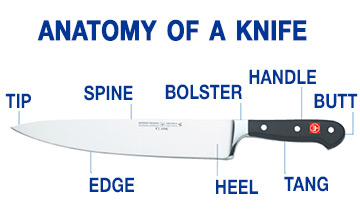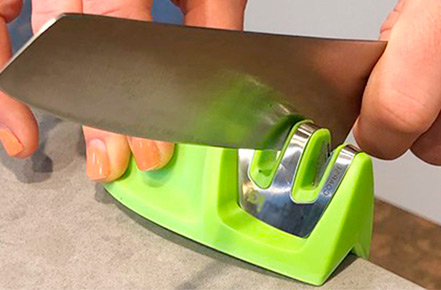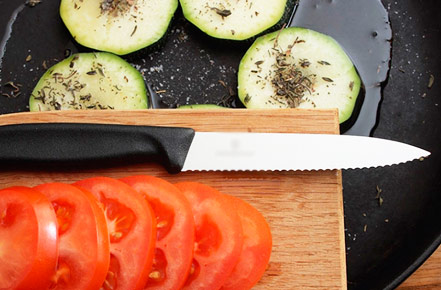-
-

-
- read more
- 15 187
-
-
-
How To Use A Knife Sharpener And Sharpen Your Knife
There are numerous ways how to properly sharpen a knife. The best way to sharpen a knife will depend on what things you have handy in your kitchen now. You ...
-
07 April 2020
-
How To Use A Knife Sharpener And Sharpen Your Knife
-
-
Learn the Difference Between Chef’s Knife vs. Santoku
Likes:Views:102Last Updated: 21 March 2023As you know, we all have different relations towards food preparation. Some people are cooking when they have to. They prefer to throw frozen meals in the microwave or eat out. For others, the kitchen is a kind of retreat where they can de-stress from daily chaos. They enjoy experimenting with recipes, watching cooking TV shows, read cookbooks, etc.
We always saw ourselves somewhere in between, though. There were moments when we felt that our creativity fully expresses itself when we are cooking. Then there were months when we just wanted to eat out. But, when this was virtually impossible, because of the lockdown, our passion kind of exponentially began to grow. We started watching cooking shows, ordering utensils and gadgets, etc. And we cooked, cooked, cooked. The more we were doing it, the more we kept discovering new exciting recipes. We have to admit we had the time of our lives. But, lots of questions, as well! For example, we couldn't figure out why everyone talks about the chef's knife and the santoku knife as they were two different things. To us, they seemed downright the same. What was the deal?
In all honesty, we weren’t purely curious about it. We also needed to buy a kitchen knife set, and God knows, the quality knife can be expensive. So, we started thinking, "Are they different, and what are their purposes?", "Do we need both of them?”. We knew that simple Googling won't give us all the answers, so we decided to look for them elsewhere. We talked with professional chefs and asked them to explain the difference, to figure out whether we need Santoku or chef’s knife or both of them. We wanted to share our findings, so we created chef’s knife vs. Santoku reviews.
Contents
What Is a Chef’s Knife?
A chef’s knife is what we call a Western-style knife. It is considered an essential tool in the kitchen. It is generally made for a pinch grip. The blade is about 8 -12 inches long from the heel to the tip. It is possible to find versions with a smaller blade approximately 6 inches long. However, if you ask professional chefs, they would say that the longer the blade, the better. This tool’s cutting edge comes with a generous curve, aka the belly. It serves for the rocking motion that you make cutting herbs.
Features
- These are French and German-style knives.
- There are zigzag varieties.
- Features curved edge.
- It comes with a double bevel.
- Heavy.
- The average size is 8-12 inches, but there are 6-inch versions.
What is a Chef Knife Used For?
It is interesting. A plethora of chef knife uses and the main reason everybody will tell you that this is a must-have tool in every kitchen. The sturdy heel of the blade is ideal for cutting through thick pieces of meat. You can use it for cutting fruit and vegetables that have hard rind like watermelon, squash, etc. If you want to do detailed work of trimming fat and scoring meat you will make great use of pointed tips. But this knife is also excellent for the rock chop technique.
What is a Santoku Knife?
Okay, now let’s see what is a Santoku knife?!
These knives are commonly used in Asian countries.
It is a Japanese variation of chef’s knives. Santoku means three virtues in Japanese. People think it refers to three things that you can do with this knife – slice, chop, and mince. Some chefs believe that it refers to three parts of the knife. Looking at the comparison chef’s knife vs. Santoku knife, you notice Santoku knife is significantly lighter and smaller. On average, these knives are between six and seven inches long. The blade is wider and has a flatter cutting edge. It features a slight curve a couple of centimeters from the tip toward the spine, unlike its Western-style counterpart.
Features
- Japanese knife.
- The wide blade without a tip.
- Thinner blade.
- There are single beveled versions.
- Lighter in weight.
- Smaller, average size varies between 5 and 8 inches.
What is a Santoku Knife Used For?
Are you wondering what is a Santoku knife used for? Well, some chefs believe that the three virtues refer to three parts of the knife – the main cutting edge for slicing; the heel for chopping; and the tip for detailed work. When it comes to Santoku knife uses it is necessary to say that you can do everything you do with a chef knife. However, the technique is different. Since it features a flat blade, Santoku will not do the rocking movement. This knife is designed for you to hold it at the handle and cut it from back up to the down front. The contact between the blade and the cutting board is lost with every cut.
Similarities
Use
As you can see, both of these knives are used for the same things. Whichever you choose, you can be sure that you will have a lot of success in cutting, chopping, and slicing the meat, fish, veggies, etc.
Handle
Both of these knives feature a full tang handle. Many people prefer full tang because it is wider and thus more efficient when you need to do some heavy-duty cutting.
Difference Between a Santoku and Chef’s Knife
Weight

When you look at the Santoku knife review, one of the first things that come to your attention is that it weighs less than the Western-style Chef knife. It is particularly useful for individuals with smaller hands.
Size
Chef’s knife is longer than Santoku knife. As we mentioned before, the average size of a Western-style knife is 8- 12 inches. Santoku is about 6 – 7 inches long.
Blade
The blade on the Santoku knife is thinner than the one on the chef’s knife. Besides, it features hollow dents on the edge of the straight blade. A sharp blade of the chef knife is broader with a pointed tip. It is also thicker.
Verdict and Our Recommendation for 2023

The bottom line is that choice between chef’s knife vs. Santoku comes down to your personal preferences and cooking style. If you have small hands, you might prefer Santoku because it is lighter and smaller, which means that it will be easier for you to work with it. A chef knife is a better option for large-handed people. Apart from that chef’s knife can be a better choice for cutting watermelons, while Santoku is ideal for cutting fish or vegetables for ratatouille. If you want to know about maintenance, you will find it interesting to read about how to sharpen the knife at home.
RELATED BLOGS-
-

-
- read more
- 6 88
-
-
-
How To Sharpen A Knife At Home
Whether we are talking about expensive or cheap knives, with or without a ceramic wrap or a wooden handle, they are all subject to the same issue, with time: they ...
-
11 December 2019
-
How To Sharpen A Knife At Home
-
-

-
- read more
- 15 162
-
-
-
Bamboo Cutting Boards Care
Do you agree that a chopping block is one of the essential kitchen utensils you can have? They come in several shapes, sizes, and thicknesses. You might have heard conflicting ...
-
19 August 2019
-
Bamboo Cutting Boards Care
related reviews
Share your thoghts








